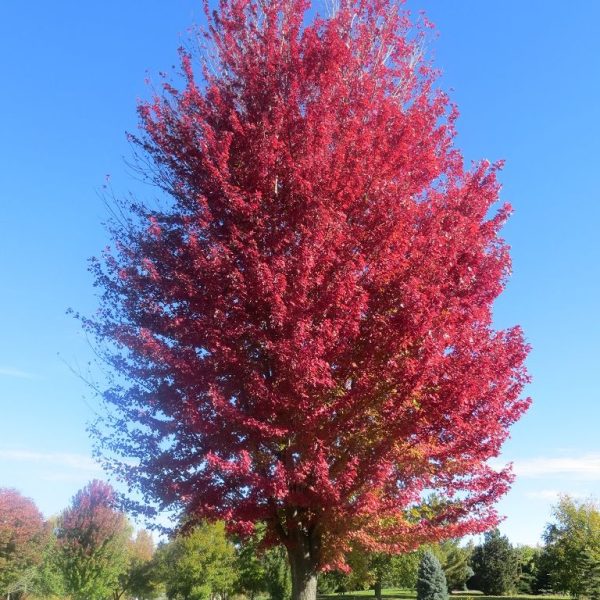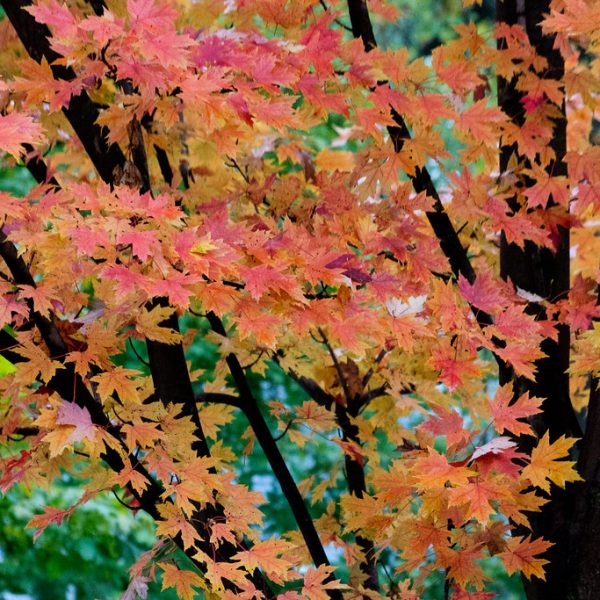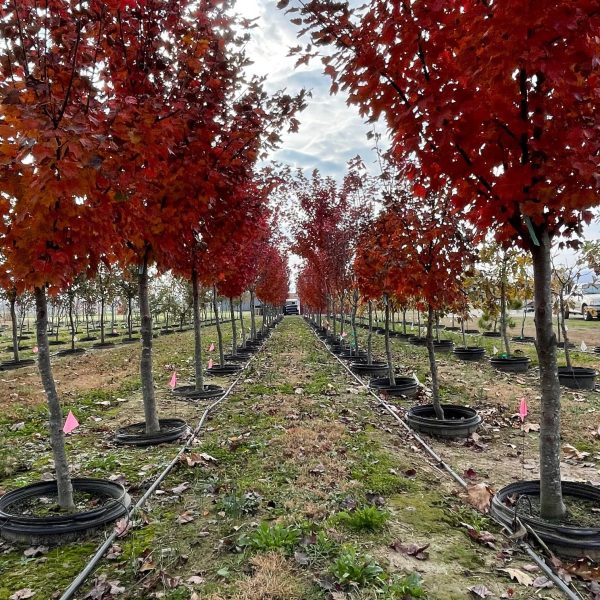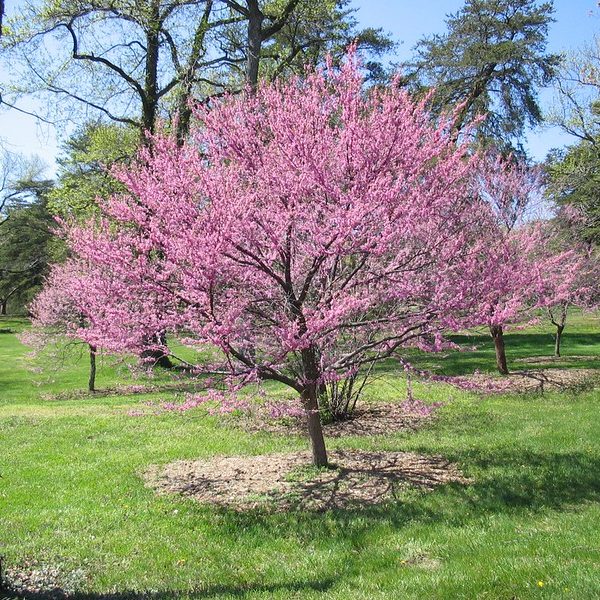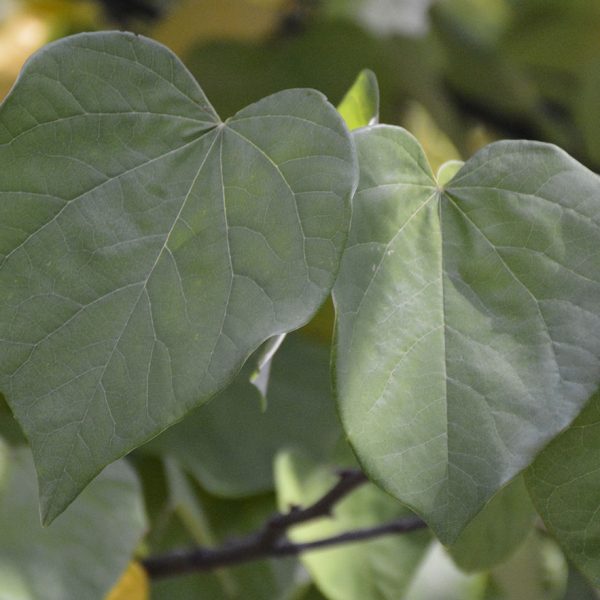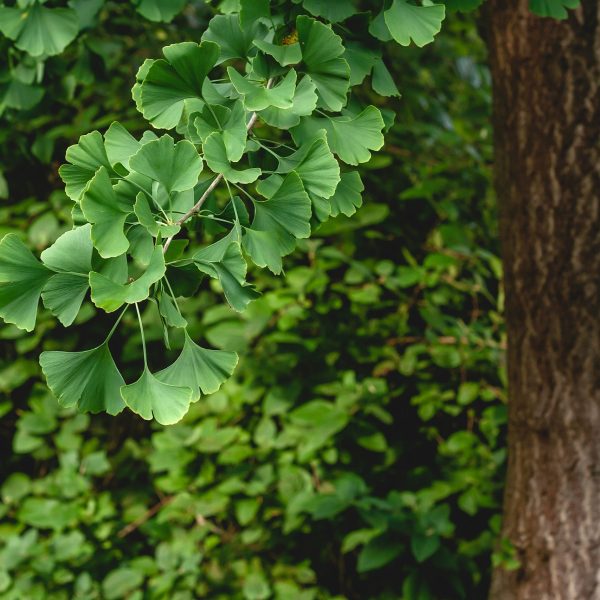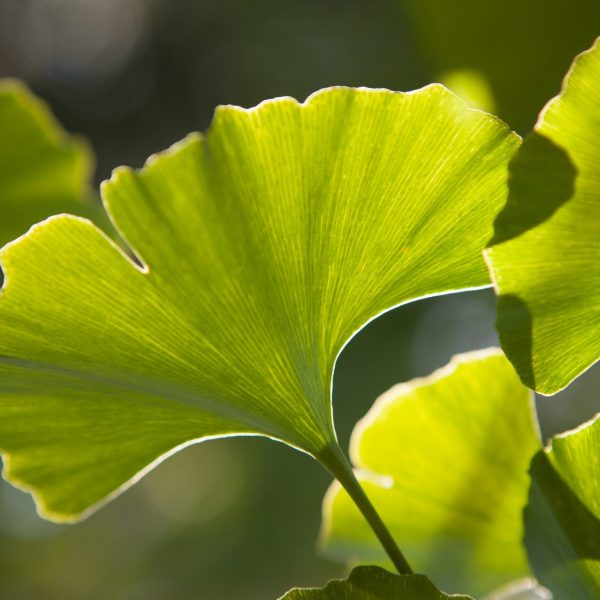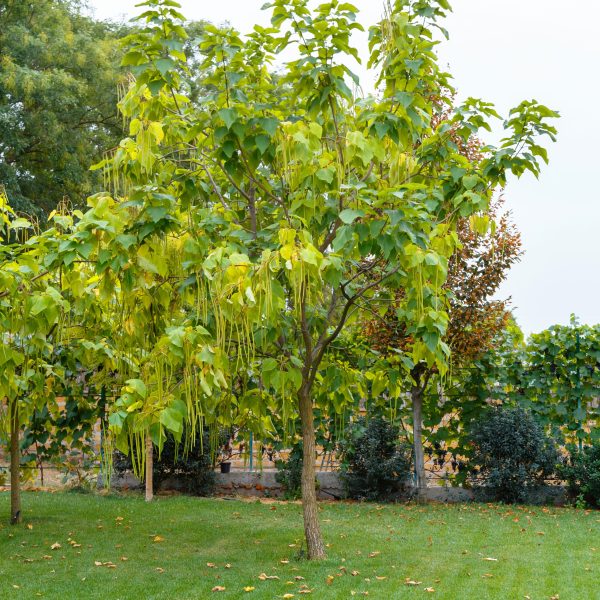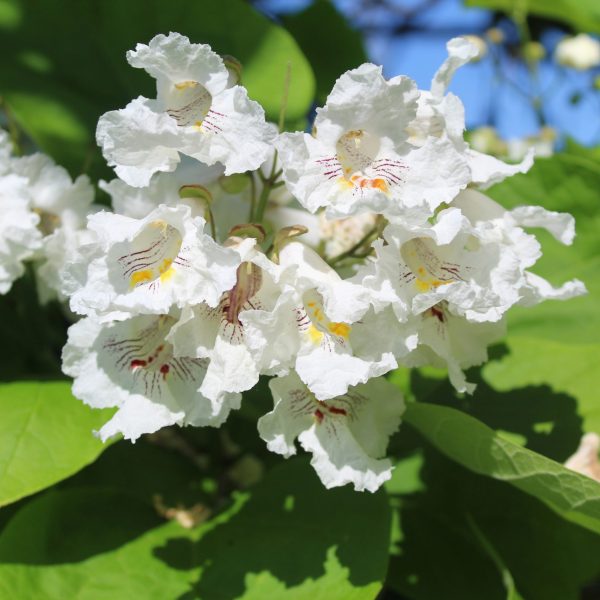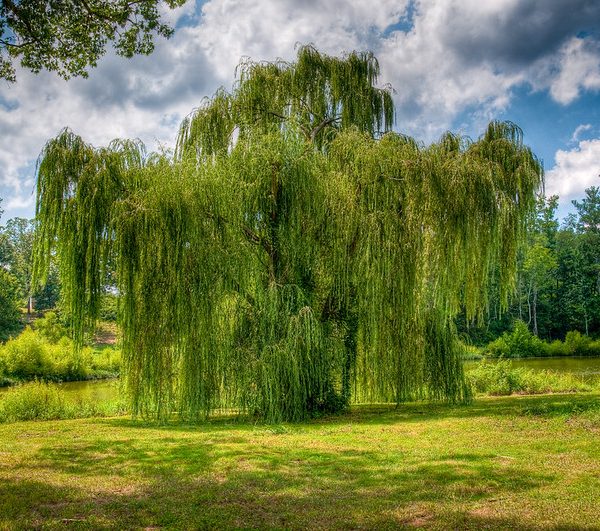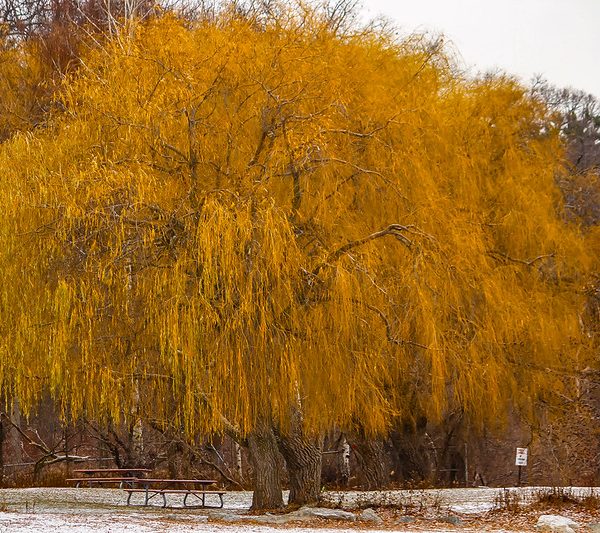Autumn Blaze Maple
The Autumn Blaze Maple is a classic oval-shaped shade tree with incredibly stylish orange/red fall color. It grows quickly and will brighten your yard in the autumn with a splash of brilliant orange/red leaves. The color often lasts longer than many other species of maple. Plant this tree if you want to brighten up your neighborhood in the fall, reduce your cooling bill in the summer or provide habitat for songbirds.
Deliberately hybridized, cultivated Autumn Blaze Maples exhibit sterility but can have small clusters of samara (i.e. dry fruit).
Bald Cypress
The Bald Cypress is a beautiful, low maintenance, easy to grow deciduous conifer that is not at all finicky about soil types and PH: from acidic to alkaline, to sand, loam clay and mildly salty soil. It’s long, slender branches feature short needles on both sides which start out yellow in spring, to light green in summer, to a yellow or coppery red in fall. Fairly insect resistant, it is a medium growing, pyramidal shaped tree who’s canopy can cast considerable shade as it matures. It loves full sun(6 hours of unobstructed sun) but can thrive in partial shade. It bears small clusters of little “globes” that produce 2 or three triangular seeds that fall in November-December. It’s nearest cousin is the Dawn Redwood, and in nurseries are often mistaken for the other.
Brandywine Maple
The Brandywine Maple is a male cultivar (no seeds) of the Red Maple: a cross with the Autumn Flame and October Glory maples. It is moderate fast growing and a bit shorter that it’s “parent” trees. Like the other Red Maple cultivars, it enjoys moist to wet well drained soil including wet clay and even some standing water which makes it a perfect choice for rain gardens. Its showy fall foliage starts out a red, then changes over to a purple or burgundy red. It keeps its fall colors longer than many other maples and is coveted by many because it does not produce the “helicopter” seeds (samaras) that female cultivar’s produce. As with other maple’s, its shallow root system is not sidewalk friendly, plant at least 20 feet from a sidewalk.
Eastern Redbud
The Eastern Red Bud is unmistakable in Spring with its spectacular pink and rose colored blossoms. Its branches branch outward low on the trunk and ensures no two redbuds look alike. Adaptable to varied soil types and PH, moderate growth rate and stunning Spring blossoms make the Eastern Red Bud a favorite accent piece to landscaped flower gardens. It prefers moist, well-drained soil and should not be planted in areas with standing water.
Ginkgo Tree
The Ginkgo Biloba is a beautiful, slow growing deciduous tree that has “leathery” green leaves in summer, turning brilliant yellow in the fall. Its fan shaped leaves are quite unique and closely resemble that of the maidenhair fern plant. The Ginkgo is frequently referred to as “the maidenhair tree”. This ancient tree is highly resistant to insects, deer and pollution. It thrives in urban plantings, likes sandy well drained soil but adapts to clay soils as well. The Ginkgo growth pattern is unique in that it grows straight up without branching outward for between 8-10 years and then begins fanning out its canopy. Not a fast-growing tree but one certainly worth the wait!
Initially thought to be extinct, Ginkgo Biloba is the only surviving specie of the family Ginkgoaceae. Considered Endangered in the wild, the Ginkgo is a living fossil dating back to the Middle Jurassic Period @ 180 million years. A few small tracts of “wild” Ginkgo’s exist today, and only in Southern Asia.
Hackberry
The Common Hackberry can grow in just about any soil, PH and moisture range. A medium to fast growing deciduous shade tree, the Hackberry grows in a pyramidal shape when young, the eventually fills out with a broad, arching canopy when mature. It has bright green leaves with serrated points on the top third and turns to a lovely yellow in fall. Mature Hackberry’s trunk-bark develops into a series of “ridges and valley’s” of irregular shape which is its unmistakable characteristic. Its fruit are small oblong “drupes” which start out red in summer, ripen and turn purple in early-mid autumn. They remain on the tree throughout winter and provide non-migrating birds a valuable food source for the winter
Northern Catalpa
If you are looking for a fast growing shade tree that has beautiful spring blooms and catches the eye: the Northern Catalpa is right up your ally. Grows in virtually any soil PH and soil type, perfect for rain gardens and chronically wet areas as well as dry areas, the Northern Catalpa is a hearty deciduous tree that can fit many purposes and isn’t finicky. Where to begin! It’s HUGE leaves grow up to a foot long, it’s beautiful and fragrant trumpet or bell shaped white flowers with purple and yellow highlights within the flower, it’s curling branches, it’s trademark fruit (long slender beans) make the Northern Catalpa an eye catching tree in spring and summer. Though its fall foliage isn’t overly showy, the leaves turn a lighter yellow in autumn. Unlike its cousin the Southern Catalpa, its leaves do not elicit any unpleasant odors. It can be either an accent piece to your landscape or a focal piece. Not practical for small yards, but a showy tree wherever planted.
Silver Maple
The Silver Maple is a fast growing shade tree that sports the signature Maple Leaf in summer with green topside, and silvery on the bottom. For many years this tree was the go to tree for growing urban street plantings because of its rapid growth, but its shallow root system made that counterproductive. It is the fastest growing maple and thrives in wet river bottom and lowlands, but tolerates drier soils as well. It is an excellent choice as a Rain Garden tree or planted in wetter than normal areas. As with all Maples, they require pruning to keep their shape and will provide shade faster than any of their Maple cousins. This is a Maple for shade and beauty in the summer, not for brilliant fall foliage. It transplants well and is a favorite for robin nesting and its signature “helicopter” seeds (samaras) are devoured by squirrels, birds and other small mammals.
Swamp White Oak
Who doesn’t admire the sight of a sturdy oak tree? The Swamp White Oak is a medium sized, moderately fast-growing Oak that grows to @ 50-60 feet tall and wide. The Swamp White Oak transplants well and is a long-lived tree: up to several hundred years as well as being a bird and pollinator favorite. It sports large, leathery, broad multi-colored leaves that are dark green on top and silvery on the bottom in summer, then turning yellow/brown and sometimes “reddish purple” in fall. Its wide, full canopy makes for an excellent shade tree or a street planting. It prefers full sun and acidic soil PH: yellowing of leaves during the summer months is a telltale sign of soils with high PH. While the Swamp White Oak thrives in lowlands near swamps and marshes in medium to wet conditions and poorly drained soils, it also tolerates clay soil and drought well.
Thornless Honey Locust
The Thornless Honey Locust is a beautiful, rapid growing shade tree that is adaptable to many soil types and displays beautiful yellow fall foliage. It provides soft shade that does not choke out grass or garden plants beneath it. Seemingly impervious to salts and pollutants, the Thornless Honey Locust does equally well in urban areas as it does in the suburbs. Though it prefers moist well drained soil, its aggressive, deep diving root system makes it highly drought resistant and driveway/sidewalk safe.
The Thornless Honey Locust produces pretty green flowers in Spring with the fragrance of honey, and when mature produce legumes (seed pods) that rabbits, squirrels and other wildlife consume.
Weeping Willow
Whose gaze doesn’t stop on the stoic, graceful Weeping Willow seen from their car window when driving by? The statuesque weeping willow can dominate a landscape and is recognized at a glance. Whether situated alone in a yard or adorning a lake or pond with its spiraling branches arching to the ground, adorned with its long, narrow bright green leaves. Adaptable to many soil types and both acidic and alkaline soils, it does prefer medium to wet conditions. It flowers in late winter or early spring on attractive yellow/green catkins.

